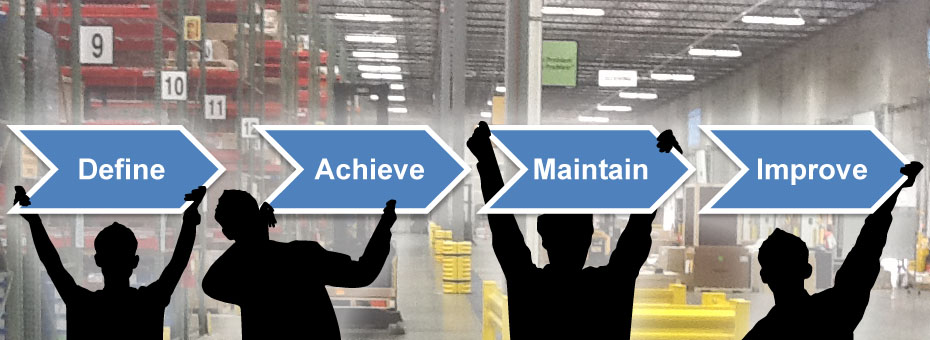We hear a lot about kaizen, but what are the actual process steps for kaizen?
I like to say, DAMI (Define, Achieve, Maintain, Improve), not to be confused with DMAIC. This was a thinking process we were all trained in when I worked at Toyota.
We never got to “settle in” or get used to a standard very long before it changed on us (through a specific improvement process of course). At first this was annoying, but then as the purpose of this was explained to us, it became our norm. In order to truly implement kaizen we knew we needed to practice the DAMI process to define a new standard from the current one.
Our leaders were there as mentors from the beginning, coaching us on the proper use of the process and making sure we engaged in dialogue at the gemba with the people who would be affected by the change. Then eventually it was expected of us as leaders (and to some extent team members), to define, achieve, maintain, and improve key processes without being told. Why? Because this was our job. Imagine this idea!
When working to strengthen business processes, so many people change things over and over (believing this is continuous improvement), but I ask them, do you have a standard for that process before you change something? Before we change anything, the current process needs to be written down and documented so it’s a benchmark for improvement. Taichii Ohno said, “There can be no kaizen without a standard.”
So let’s take a look at this DAMI process, which can be used in any type of organization and industry. What is it and how does it work?
Define
The first step is to Define a standard, ideal state, the expectations, or possibly the scope of work for an individual. It’s an act of respect for people to give them clear expectations of what the standards are so they can then meet an internal or external customer need. Sometimes we don’t know what will meet expectations, but we need to start somewhere. Like the ole’ saying goes, how do you know where you are going if you don’t know where you are? This is also true for continuous improvement.
Achieve
Once we have defined what we feel at the time is the best known method to perform our process, we need to ask the question: Can we Achieve it? Oftentimes organizations “over-promise” and find themselves not able to achieve standards based on meeting a sales need, not understanding total capability internally. So achievability is important.
In our early days of production at Toyota (TMMK plant), we knew we needed to make a car every 60 seconds. This is what we defined as the standard based on the customer need at that time (takt time). We went through several iterations of the process in order to achieve the 60 second standard. But we did it and the standard was achievable to our disbelief from where we were just two months before that.
Maintain
If you reach the achievable stage then we must Maintain it for a period of time. My Japanese trainers would often say “lucky is not sustainable,” meaning if you get lucky and achieve your results with a non-repeatable or unsustainable process then you are just lucky. Who wants to base their business model on luck?
After we define and achieve, we must be able to prove we can sustain/maintain the new process/improvement every day for each output we create. For us this may be a 2–3 month period. Remember, this happens through measuring the process daily against the standard. If a standard is in place you should be able to differentiate the “plan versus actual” easily. All standards should allow us to see abnormality at a glance. So if it’s not maintainable then we need to revisit the achievability of the standard (define).
I think it’s funny when organizations reach the “maintain” phase because they feel they are “winning” as Charlie Sheen would say! Winning! But in the continuous improvement mindset “maintaining” is not the stopping point. There is still one more step.
Improve
The most overlooked step in true continuous improvement is the actual “measurability” of the Improve step (creating a new standard if you are meeting the current one). So many continuous improvement leaders say, “We are improving.” I ask, “How do you know? They might say, “We are making change.” Again though, how do they know? This is where I see so many discrepancies and unexpected errors happen, most of which tend to root back to fact that the standard or ideal state was never truly defined or documented so it could be achieved and measured.
Continuous improvement in its true fashion is not easy, especially when we are asked to measure it and prove it. I can change something every day to make it appear like I am improving, but improvement without measures is waste. Kaizen without value isn’t kaizen. You must measure value. Without clear standards this is impossible.
At Toyota, we were never to be complacent or happy with just maintaining something. If you couldn’t see a problem in a process, you were expected to purposely create a gap. Think about that! What type of organization creates a problem to solve when there is none? Why might we do such a thing?
A lesson I learned from my trainer was “Never be comfortable. If you are comfortable then you are not learning.” So change it up folks! You must define, achieve, maintain, and improve if you really want to practice kaizen.
Think of it this way: If it isn’t broke… “purposely” break it!
Key Concepts of Lean Management
Get a proper introduction to lean management.






